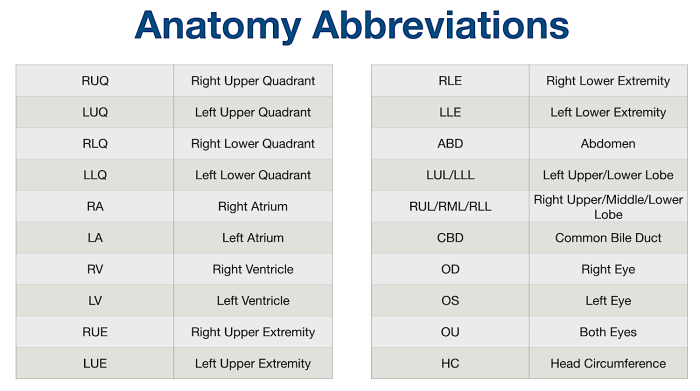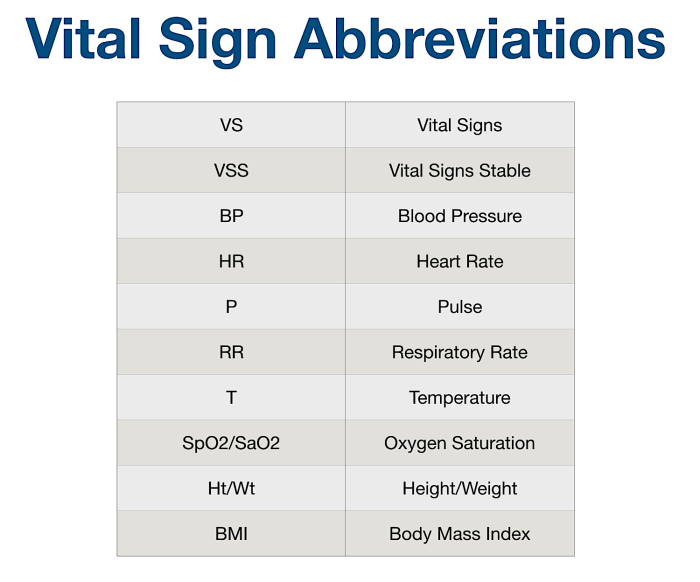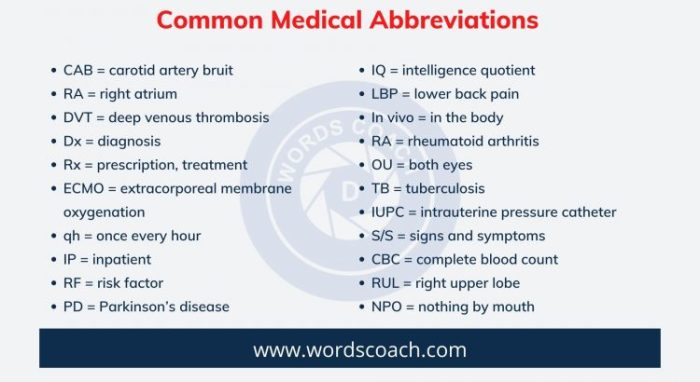SUD medical abbreviation stands as a beacon of understanding in the complex realm of substance use disorders, guiding healthcare professionals and individuals alike toward informed decisions and effective interventions.
Delving into the depths of SUDs, we embark on a journey to decipher their types, unravel their underlying causes, and explore the multifaceted strategies for diagnosis, treatment, and prevention.
Definition and Meaning of SUD Medical Abbreviation

The medical abbreviation SUD stands for substance use disorder. It is a term used to describe a range of conditions characterized by the compulsive use of substances, including drugs and alcohol. SUDs can range in severity from mild to severe and can have a significant impact on an individual’s physical, mental, and social well-being.
Purpose and Usage of SUD in Healthcare Settings
SUD is used in healthcare settings to identify and diagnose individuals who are struggling with substance use. It is also used to track the progress of treatment and to develop individualized treatment plans. SUD can be diagnosed using a variety of criteria, including the presence of withdrawal symptoms, tolerance, and compulsive use.
Treatment for SUD typically involves a combination of medication, therapy, and support groups.
Types of SUDs

Substance use disorders (SUDs) are characterized by the compulsive use of substances despite negative consequences. Different types of SUDs exist, each with its unique characteristics and associated substances.
Common types of SUDs include:
Alcohol Use Disorder
- Excessive alcohol consumption leading to impaired control, tolerance, withdrawal symptoms, and social or occupational problems.
Opioid Use Disorder
- Compulsive use of opioids, such as heroin or prescription painkillers, resulting in dependence, tolerance, and withdrawal symptoms.
Cannabis Use Disorder
- Excessive cannabis use leading to problems with relationships, work, or school, as well as increased risk of mental health issues.
Stimulant Use Disorder, Sud medical abbreviation
- Compulsive use of stimulants, such as cocaine or methamphetamine, causing increased energy, alertness, and decreased appetite, often leading to dependence and withdrawal symptoms.
Sedative, Hypnotic, or Anxiolytic Use Disorder
- Excessive use of sedatives, hypnotics, or anxiolytics, such as benzodiazepines or barbiturates, leading to dependence, tolerance, and withdrawal symptoms.
Causes and Risk Factors of SUDs
Substance use disorders (SUDs) are complex conditions influenced by a combination of genetic, environmental, and psychological factors. Understanding these underlying causes and risk factors is crucial for developing effective prevention and treatment strategies.
Genetic Influences
Genetic factors play a significant role in the development of SUDs. Studies have shown that individuals with a family history of substance abuse are more likely to develop the disorder themselves. Specific genes have been identified that increase the risk of SUDs, including those involved in dopamine signaling, reward pathways, and stress response.
Environmental Influences
Environmental factors also contribute to the development of SUDs. These include:
- Exposure to substances:Early exposure to substances, such as alcohol or tobacco, can increase the risk of developing a SUD later in life.
- Trauma and stress:Traumatic experiences, such as childhood abuse or neglect, can increase the risk of SUDs as a coping mechanism.
- Social and peer influences:Peer pressure, social norms, and availability of substances can influence an individual’s likelihood of using and abusing substances.
Psychological Influences
Psychological factors also play a role in the development of SUDs. These include:
- Mental health disorders:Individuals with mental health disorders, such as depression or anxiety, are more likely to develop SUDs.
- Personality traits:Certain personality traits, such as impulsivity, sensation-seeking, and low self-esteem, can increase the risk of SUDs.
- Cognitive biases:Individuals with SUDs often have cognitive biases that make them more likely to use and abuse substances, such as believing that substances will solve their problems.
Understanding the causes and risk factors of SUDs is essential for developing targeted prevention and treatment programs. By addressing these underlying factors, we can reduce the incidence and impact of SUDs on individuals, families, and communities.
Symptoms and Signs of SUDs
Substance use disorders (SUDs) manifest through a range of physical, psychological, and behavioral symptoms. These signs and indicators can vary depending on the specific substance being abused, but there are some commonalities.
Physical Symptoms
Physical symptoms of SUDs may include:
- Changes in appetite or weight
- Sleep disturbances
- Fatigue or lethargy
- Tremors or seizures
- Skin problems
- Gastrointestinal issues
Psychological Symptoms
Psychological symptoms of SUDs may include:
- Anxiety or depression
- Mood swings
- Irritability
- Paranoia
- Hallucinations
- Delusions
Behavioral Symptoms
Behavioral symptoms of SUDs may include:
- Increased substance use
- Neglecting responsibilities
- Withdrawal from social activities
- Legal problems
- Financial problems
- Relationship problems
Observable signs and indicators of SUDs can include:
- Bloodshot eyes
- Dilated pupils
- Slurred speech
- Impaired coordination
- Changes in hygiene
- Presence of drug paraphernalia
Diagnosis and Assessment of SUDs
Diagnosing and assessing substance use disorders (SUDs) is crucial for developing appropriate treatment plans. It involves a comprehensive evaluation to determine the presence, severity, and specific characteristics of SUDs.
Various diagnostic tools and assessment methods are used in the diagnosis and assessment of SUDs. These include:
Diagnostic Tools
- Diagnostic and Statistical Manual of Mental Disorders (DSM-5): A widely used diagnostic manual that provides criteria for diagnosing mental disorders, including SUDs.
- International Classification of Diseases (ICD-11): Another diagnostic manual that provides criteria for diagnosing diseases and health conditions, including SUDs.
Assessment Methods
- Clinical interview: A structured interview conducted by a healthcare professional to gather information about the individual’s substance use history, patterns, and consequences.
- Physical examination: A physical exam to assess for signs of substance use, such as withdrawal symptoms or drug-related health problems.
- Laboratory tests: Tests to detect the presence of substances in the body, such as blood or urine tests.
- Self-report measures: Questionnaires or surveys that ask individuals about their substance use and related behaviors.
- Collateral information: Information gathered from family members, friends, or other individuals who have knowledge of the individual’s substance use.
Treatment and Management of SUDs: Sud Medical Abbreviation

The treatment of SUDs involves a multifaceted approach that addresses the physical, psychological, and social aspects of the condition. Various treatment options are available, including pharmacological interventions, behavioral therapies, and support groups, tailored to the individual’s needs and circumstances.
Pharmacological Interventions
Pharmacological interventions play a crucial role in managing SUDs, particularly in reducing withdrawal symptoms, preventing relapse, and addressing co-occurring mental health conditions. Medications used for SUDs include:
- Opioid agonists (e.g., methadone, buprenorphine) to reduce cravings and withdrawal symptoms in opioid use disorder
- Naltrexone to block the effects of opioids and reduce cravings
- Acamprosate to reduce cravings and prevent relapse in alcohol use disorder
- Disulfiram to cause unpleasant reactions when alcohol is consumed, deterring further use
- Antidepressants and antipsychotics to address co-occurring mental health conditions
Prevention and Education about SUDs
Preventing SUDs requires a multifaceted approach involving public health initiatives, education, and community involvement. Effective strategies include:
Early Intervention and Education
Educating youth about the risks and consequences of substance use is crucial. School-based programs, peer support groups, and community outreach initiatives can help raise awareness, promote healthy decision-making, and reduce the likelihood of SUD development.
Restrictive Policies and Access
Implementing strict policies that limit access to substances, such as raising the legal drinking age, restricting the sale of certain drugs, and enforcing penalties for underage drinking, can reduce the availability and consumption of substances.
Community Support and Treatment
Creating supportive environments where individuals can access treatment and recovery services is essential. Community health centers, support groups, and rehabilitation programs provide individuals with the resources and guidance they need to overcome SUDs.
Public Health Campaigns
Public health campaigns that raise awareness about the dangers of SUDs, promote healthy behaviors, and encourage help-seeking can effectively reduce the stigma associated with substance use and increase the likelihood of individuals seeking treatment.
Ultimate Conclusion
In the tapestry of healthcare, SUD medical abbreviation serves as a vital thread, connecting patients, providers, and researchers in the pursuit of recovery and well-being. Through a comprehensive understanding of SUDs, we empower individuals to reclaim their lives from the clutches of addiction.
FAQ Guide
What is the full form of SUD?
SUD stands for Substance Use Disorder.
What is the purpose of using SUD in healthcare?
SUD provides a standardized acronym for healthcare professionals to communicate effectively about substance use disorders.
What are the common types of SUDs?
Common types of SUDs include alcohol use disorder, opioid use disorder, and cannabis use disorder.
What are the signs and symptoms of SUDs?
Signs and symptoms of SUDs may include changes in behavior, physical health, and mental health.
How are SUDs diagnosed and assessed?
SUDs are diagnosed and assessed through a combination of clinical interviews, physical exams, and diagnostic tools.